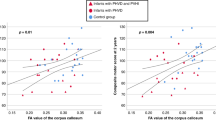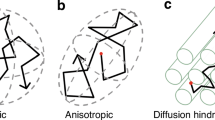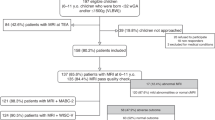Abstract
White matter microstructural changes can be detected with diffusion tensor imaging. It was hypothesized that diffusion parameters in the posterior limb of the internal capsule (PLIC) and corpus callosum (CC) bundles in preterm infants at term equivalent age (TEA) were associated with neurodevelopment at 2 y corrected age. In 67 preterm infants, fiber tracking was performed at TEA for the CC and both PLIC bundles. Volume, length, fractional anisotropy (FA), mean diffusivity, axial diffusivity, and radial diffusivity were determined for the three bundles. These parameters were assessed in relation to outcome on the Bayley Scales of Infant and Toddler Development III. In girls, volume and length of the CC bundle and right PLIC bundle volume were associated with cognition. In boys, volume, FA, mean and radial diffusivity, and length of the left PLIC were associated with fine motor scores. Correction for GA, birth weight, intraventricular hemorrhage, white matter injury, and maternal education did not change the results. Fiber tracking parameters in the PLIC and CC bundles in preterm infants at TEA revealed different associations with neurodevelopment between boys and girls. This study suggested that fiber tracking is a useful method to predict neurodevelopment in preterm infants.
Similar content being viewed by others

Log in or create a free account to read this content
Gain free access to this article, as well as selected content from this journal and more on nature.com
or
Abbreviations
- AD:
-
axial diffusivity
- ADC:
-
apparent diffusion coefficient
- BSITD-III:
-
Bayley Scales of Infant and Toddler Development; Third Edition
- BW:
-
birth weight
- CC:
-
corpus callosum
- Cl:
-
“case linear” anisotropy index
- DTI:
-
diffusion tensor imaging
- FA:
-
fractional anisotropy
- IVH:
-
intraventricular hemorrhages
- MD:
-
mean diffusivity
- PLIC:
-
posterior limb of the internal capsule
- RD:
-
radial diffusivity
- ROI:
-
region of interest
- TE:
-
echo time
- TEA:
-
term equivalent age
- TR:
-
repetition time
- WM:
-
white matter.
References
Volpe JJ 2008 Neurology of the Newborn. Saunders/Elsevier, Philadelphia
Dyet LE, Kennea N, Counsell SJ, Maalouf EF, Ajayi-Obe M, Duggan PJ, Harrison M, Allsop JM, Hajnal J, Herlihy AH, Edwards B, Laroche S, Cowan FM, Rutherford MA, Edwards AD 2006 Natural history of brain lesions in extremely preterm infants studied with serial magnetic resonance imaging from birth and neurodevelopmental assessment. Pediatrics 118: 536–548
Spittle AJ, Boyd RN, Inder TE, Doyle LW 2009 Predicting motor development in very preterm infants at 12 months' corrected age: the role of qualitative magnetic resonance imaging and general movements assessments. Pediatrics 123: 512–517
Mirmiran M, Barnes PD, Keller K, Constantinou JC, Fleisher BE, Hintz SR, Ariagno RL 2004 Neonatal brain magnetic resonance imaging before discharge is better than serial cranial ultrasound in predicting cerebral palsy in very low birth weight preterm infants. Pediatrics 114: 992–998
Hüppi PS, Dubois J 2006 Diffusion tensor imaging of brain development. Semin Fetal Neonatal Med 11: 489–497
Basser PJ, Mattiello J, LeBihan D 1994 MR diffusion tensor spectroscopy and imaging. Biophys J 66: 259–267
Mori S, van Zijl PC 2002 Fiber tracking: principles and strategies—a technical review. NMR Biomed 15: 468–480
Ment LR, Hirtz D, Huppi PS 2009 Imaging biomarkers of outcome in the developing preterm brain. Lancet Neurol 8: 1042–1055
Mathur AM, Neil JJ, Inder TE 2010 Understanding brain injury and neurodevelopmental disabilities in the preterm infant: the evolving role of advanced magnetic resonance imaging. Semin Perinatol 34: 57–66
Miller SP, Vigneron DB, Henry RG, Bohland MA, Ceppi-Cozzio C, Hoffman C, Newton N, Partridge JC, Ferriero DM, Barkovich AJ 2002 Serial quantitative diffusion tensor MRI of the premature brain: development in newborns with and without injury. J Magn Reson Imaging 16: 621–632
Rabinowicz T, Petetot JM, Gartside PS, Sheyn D, Sheyn T, de CM 2002 Structure of the cerebral cortex in men and women. J Neuropathol Exp Neurol 61: 46–57
Schmithorst VJ, Holland SK, Dardzinski BJ 2008 Developmental differences in white matter architecture between boys and girls. Hum Brain Mapp 29: 696–710
Wilde EA, McCauley SR, Chu Z, Hunter JV, Bigler ED, Yallampalli R, Wang ZJ, Hanten G, Li X, Ramos MA, Sabir SH, Vasquez AC, Menefee D, Levin HS 2009 Diffusion tensor imaging of hemispheric asymmetries in the developing brain. J Clin Exp Neuropsychol 31: 205–218
Arzoumanian Y, Mirmiran M, Barnes PD, Woolley K, Ariagno RL, Moseley ME, Fleisher BE, Atlas SW 2003 Diffusion tensor brain imaging findings at term-equivalent age may predict neurologic abnormalities in low birth weight preterm infants. AJNR Am J Neuroradiol 24: 1646–1653
Drobyshevsky A, Bregman J, Storey P, Meyer J, Prasad PV, Derrick M, MacKendrick W, Tan S 2007 Serial diffusion tensor imaging detects white matter changes that correlate with motor outcome in premature infants. Dev Neurosci 29: 289–301
Rose J, Butler EE, Lamont LE, Barnes PD, Atlas SW, Stevenson DK 2009 Neonatal brain structure on MRI and diffusion tensor imaging, sex, and neurodevelopment in very-low-birthweight preterm children. Dev Med Child Neurol 51: 526–535
Krishnan ML, Dyet LE, Boardman JP, Kapellou O, Allsop JM, Cowan F, Edwards AD, Rutherford MA, Counsell SJ 2007 Relationship between white matter apparent diffusion coefficients in preterm infants at term-equivalent age and developmental outcome at 2 years. Pediatrics 120: e604–e609
Yoo SS, Park HJ, Soul JS, Mamata H, Park H, Westin CF, Bassan H, du Plessis AJ, Robertson RL Jr, Maier SE, Ringer SA, Volpe JJ, Zientara GP 2005 In vivo visualization of white matter fiber tracts of preterm- and term-infant brains with diffusion tensor magnetic resonance imaging. Invest Radiol 40: 110–115
Zhai G, Lin W, Wilber KP, Gerig G, Gilmore JH 2003 Comparisons of regional white matter diffusion in healthy neonates and adults performed with a 3.0-T head-only MR imaging unit. Radiology 229: 673–681
Berman JI, Mukherjee P, Partridge SC, Miller SP, Ferriero DM, Barkovich AJ, Vigneron DB, Henry RG 2005 Quantitative diffusion tensor MRI fiber tractography of sensorimotor white matter development in premature infants. Neuroimage 27: 862–871
de Vries LS, van Haastert IC, Rademaker KJ, Koopman C, Groenendaal F 2004 Ultrasound abnormalities preceding cerebral palsy in high-risk preterm infants. J Pediatr 144: 815–820
Woodward LJ, Anderson PJ, Austin NC, Howard K, Inder TE 2006 Neonatal MRI to predict neurodevelopmental outcomes in preterm infants. N Engl J Med 355: 685–694
Vilanova A, Berenschot G, van Pul C 2004 DTI visualization with streamsurfaces and evenly-spaced volume seeding. In: Deussen O, Hansen C, Keim DA, Saupte D (eds) Joint EUROGRAPHICS—IEEE TCVG Symposium on Visualization, pp 173–182. Eurographics Association, Konstanz, Germany
Gilmore JH, Lin W, Corouge I, Vetsa YS, Smith JK, Kang C, Gu H, Hamer RM, Lieberman JA, Gerig G 2007 Early postnatal development of corpus callosum and corticospinal white matter assessed with quantitative tractography. AJNR Am J Neuroradiol 28: 1789–1795
van Pul C, Buijs J, Vilanova A, Roos FG, Wijn PF 2006 Infants with perinatal hypoxic ischemia: feasibility of fiber tracking at birth and 3 months. Radiology 240: 203–214
Bayley N 2006 Bayley Scales of Infant and Toddler Development, 3rd ed. Pearson Education, San Antonio
Hüppi PS, Warfield S, Kikinis R, Barnes PD, Zientara GP, Jolesz FA, Tsuji MK, Volpe JJ 1998 Quantitative magnetic resonance imaging of brain development in premature and mature newborns. Ann Neurol 43: 224–235
Davatzikos C, Resnick SM 1998 Sex differences in anatomic measures of interhemispheric connectivity: correlations with cognition in women but not men. Cereb Cortex 8: 635–640
Kontis D, Catani M, Cuddy M, Walshe M, Nosarti C, Jones D, Wyatt J, Rifkin L, Murray R, Allin M 2009 Diffusion tensor MRI of the corpus callosum and cognitive function in adults born preterm. Neuroreport 20: 424–428
Nagy Z, Westerberg H, Skare S, Andersson JL, Lilja A, Flodmark O, Fernell E, Holmberg K, Bohm B, Forssberg H, Lagercrantz H, Klingberg T 2003 Preterm children have disturbances of white matter at 11 years of age as shown by diffusion tensor imaging. Pediatr Res 54: 672–679
Skranes J, Vangberg TR, Kulseng S, Indredavik MS, Evensen KA, Martinussen M, Dale AM, Haraldseth O, Brubakk AM 2007 Clinical findings and white matter abnormalities seen on diffusion tensor imaging in adolescents with very low birth weight. Brain 130: 654–666
Vasileiadis GT, Thompson RT, Han VK, Gelman N 2009 Females follow a more “compact” early human brain development model than males. A case-control study of preterm neonates. Pediatr Res 66: 551–555
Gilmore JH, Lin W, Prastawa MW, Looney CB, Vetsa YS, Knickmeyer RC, Evans DD, Smith JK, Hamer RM, Lieberman JA, Gerig G 2007 Regional gray matter growth, sexual dimorphism, and cerebral asymmetry in the neonatal brain. J Neurosci 27: 1255–1260
Van Essen DC 1997 A tension-based theory of morphogenesis and compact wiring in the central nervous system. Nature 385: 313–318
Haier RJ, Jung RE, Yeo RA, Head K, Alkire MT 2005 The neuroanatomy of general intelligence: sex matters. Neuroimage 25: 320–327
Reiss AL, Kesler SR, Vohr B, Duncan CC, Katz KH, Pajot S, Schneider KC, Makuch RW, Ment LR 2004 Sex differences in cerebral volumes of 8-year-olds born preterm. J Pediatr 145: 242–249
Wood NS, Costeloe K, Gibson AT, Hennessy EM, Marlow N, Wilkinson AR 2005 The EPICure study: associations and antecedents of neurological and developmental disability at 30 months of age following extremely preterm birth. Arch Dis Child Fetal Neonatal Ed 90: F134–F140
Acknowledgements
We thank Dr. Cuno S.P.M. Uiterwaal for his support in the statistical analysis; the families who took part in the study; Niels Blanken and the other MR technicians of the MR institute for their expert and enthusiastic help; and our colleagues of the NICU and Medium care of the Wilhelmina Children's Hospital in Utrecht, The Netherlands.
Author information
Authors and Affiliations
Corresponding author
Additional information
Supported by The Netherlands Organization for Health Research and Development, project 94527022.
The authors report no conflicts of interest.
Rights and permissions
About this article
Cite this article
van Kooij, B., van Pul, C., Benders, M. et al. Fiber Tracking at Term Displays Gender Differences Regarding Cognitive and Motor Outcome at 2 Years of Age in Preterm Infants. Pediatr Res 70, 626–632 (2011). https://doi.org/10.1203/PDR.0b013e318232a963
Received:
Accepted:
Issue date:
DOI: https://doi.org/10.1203/PDR.0b013e318232a963
This article is cited by
-
Diffusion Tensor Tractography of the Cerebellar Peduncles in Prematurely Born 7-Year-Old Children
The Cerebellum (2017)
-
Neonatal brain microstructure correlates of neurodevelopment and gait in preterm children 18–22 mo of age: an MRI and DTI study
Pediatric Research (2015)
-
Data quality in diffusion tensor imaging studies of the preterm brain: a systematic review
Pediatric Radiology (2015)
-
A crucial role for white matter alterations in interference control problems of very preterm children
Pediatric Research (2014)
-
Isolated mild white matter signal changes in preterm infants: a regional approach for comparison of cranial ultrasound and MRI findings
Journal of Perinatology (2014)


